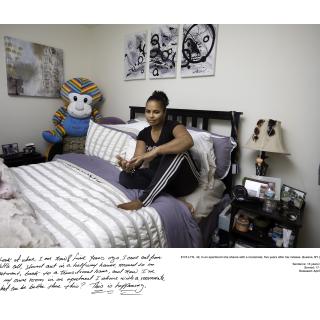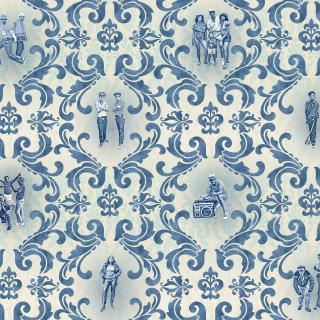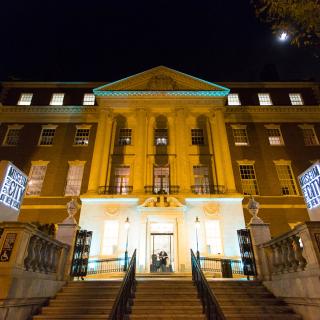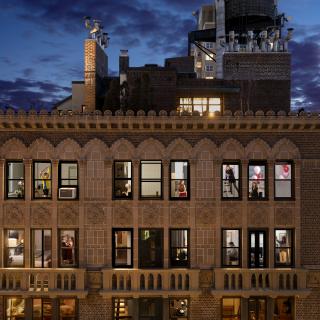New York Now: Home Crosses Borders
Home Crosses Borders
Climate crisis, war, religious persecution, unstable employment: these are just a few of many causes that force people to uproot their lives, often at great risk and expense, to make homes across land and sea. New York City has long been the landing pad for immigrants, refugees, and asylum seekers arriving with hopes of making better lives. The photographic archives of these communities attest to both the triumphs and the grave challenges they face once here.
Perhaps the most iconic photographs of immigrants in New York are those from the collection of Jacob Riis (1849–1914), whose images of the Lower East Side’s tenements and its working-class residents are now held in the Museum’s archives. Following this photographic tradition, contemporary photographers and visual artists continue to poignantly document the travails of diasporic and migrant communities making home in the city today.
What makes this exhibition’s images distinctive from earlier representations is, in large part, the photographer’s gaze. Artists like Xyza Cruz Bacani, Cinthya Santos-Briones, and Diana Guerra do not pretend to be objective, taking well-meaning but voyeuristic photographs of the abject immigrant “other.” Working collaboratively with their subjects, these artists instead complicate mainstream narratives of migration and uncover the difficult work of rebuilding lives and homes across geographic borders, cultural distances, and racial and ethnic lines.
CINTHYA SANTOS-BRIONES
1. Living in Sanctuary, October 20, 2017
2. Dulce, October 5, 2017
3. Daniel and a Fictional Character, January 10, 2018
4. Holyrood Church, September 30, 2017
5. The Refuge is a Sanctuary, September 22, 2017
6. Aerialists, September 25, 2017
7. The Library Shelters Our Dreams, September 25, 2017
8. Amanda, September 26, 2017
From the series “Living in Sanctuary”
ARCHIVAL PIGMENT PRINTS
In August 2017, Amanda Morales and her three children Dulce, Daniela, and David left their home in Long Island to seek sanctuary in Holyrood Episcopal Church/Iglesia Santa Cruz in Washington Heights. Amanda had first fled to the US from civil conflict in Guatemala in 2004. She was then threatened with deportation by US Immigration and Customs Enforcement (ICE) and had no choice but to uproot herself again. The church’s leaders and congregation opened their doors to the family, continuing the legacy of the original sanctuary movement of the 1980s, a religious and political campaign that sheltered Central American refugees despite US government opposition.
Mexican anthropologist, community organizer, and photographer Cinthya Santos-Briones collaborated with the family to make “Living in Sanctuary,” a poignant documentary series about their making home inside of the church within the larger context of faith-based resistance movements. The images reveal Amanda and her children’s small joys amidst their loneliness in being separated from the outside world, their friends, and their larger family. They also highlight the cruelty of forced family separation, and make a case for reforming US immigration policies to save the lives and homes of all asylum-seekers.
XYZA CRUZ BACANI
1. Farah Wears a Hijab, 2015
2. Farah and Shipu After Prayers, 2017
3. Farah and Shipu’s Wedding Photo, 2015
4. Farah Inside the Masjid With the Bengali Women, 2015
5. Liberty, 2022
6. Farah and Shipu Prepare Iftar Ending Ramadan Fast With Friends, 2017
7. Farah at the Subway Platform in Brooklyn, 2015
8. Farah and Shipu Party With Their Bangladeshi Friends in Queens, 2018
9. Farah Buying Halal Food in Queens, 2015
From the series “We Are Like Air: NYC”
ARCHIVAL PIGMENT PRINTS
Xyza Cruz Bacani is a Filipina photographer and author with a personal and professional interest in labor migration and human rights. While herself a domestic worker in Hong Kong, Bacani began photographing the hidden lives of exploited migrant women from the Philippines, including that of her own mother.
For New York Now, Bacani shares images from the life of Farah, a Filipina survivor of labor trafficking living in Queens. Farah worked as a teacher without receiving her promised salary, forcing her to be a part-time nanny, housekeeper, and babysitter to pay off her debt bondage. Eventually, Farah became a US legal resident and married into a Bengali immigrant family. Bacani’s collaboration with Farah spanned seven years, recording everything from the mundane tasks of grocery shopping and attending mosque, to Farah’s community organizing, to a memorable family vacation at Niagara Falls. These photographs sensitively document a migrant woman’s journey towards safety and security in her adopted home.
LEFT
AMARISE CARRERAS
Our Love, Safety, and Rage is Our Protection (Brujo), 2022
MIXED MEDIA
In some Puerto Rican and other Latinx and Caribbean households, home altars adorned with food, tobacco, photos, or additional offerings are constructed to venerate ancestors; altars might be drawn from Catholic rituals or Santería and other syncretic traditions. Inspired by their bisabuela’s altars and their larger matriarchal and queer lineages, Queens-raised artist Amarise Carreras produces their own photo-based and performative installations such as Our Love, Safety, and Rage is Our Protection (Brujo).
In this altar, the familiar domestic objects of domino tiles, oyster shells, family photographs, a houseplant, candles, and cinnamon sticks create a type of queer fortitude against the multiple and overlapping forces impacting Puerto Ricans on the island and in the diaspora: racism, homophobia, and the environmental destruction wrought by hurricanes. Carreras explains, “Upon inspection and study, each item narrates a lost history that invites a displaced body; queer, trans, diasporic, and migrant, to enter. These altars and images document survival and the process of my body’s renewal.”
RIGHT
DIANA GUERRA
Estamos Aquí (We Are Here), 2020
RUN TIME: 09:20 MINUTES
In Estamos Aquí (We Are Here), Peruvian American photographer, art educator, and activist Diana Guerra follows a young man from Guatemala on his daily commute through New York City on the subway, bus, and by foot. The grainy Super 8 footage of Guerra’s faceless subject moving through the city is interspersed with found video and still footage that evoke family and urban life in Guatemala and the working-class conditions of living in New York, such as TV advertisements for cleaning products to make domestic work easier.
The film is largely silent, save for questions asked by the filmmaker to the young man about his difficult border-crossing experience and the daily labor he performs. At times, however, the quiet is disconcertingly punctuated by sonic interruptions of an American-accent lesson and the national anthem of Guatemala played in the style of marimba. While focused on one young person’s life, the film poetically uncovers the feelings of alienation and dislocation experienced by many working-class immigrants as they try to make their way in new and hostile environments.
Image Credit: Cinthya Santos-Briones, Aerialists, September 25, 2017. Courtesy of the artist.







